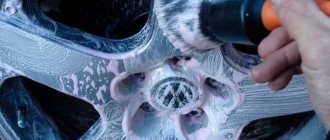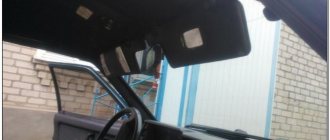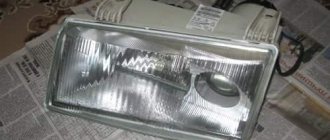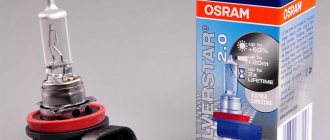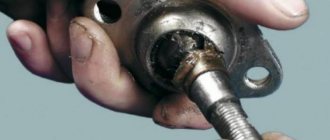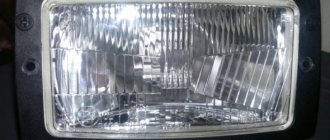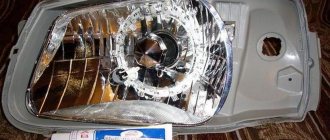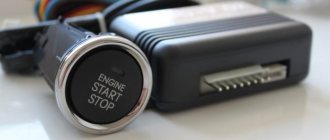Cars are different - luxury foreign cars and old domestic cars. But they all face the problem of poor headlight illumination. This is natural and the “class” of your vehicle will not protect you from such troubles. Long-term use, weather conditions, dust in the garage - all this affects the intensity of illumination and the flow that the headlights produce. They tend to fade over the years.
The beam becomes not only “weak”, but also scattered. It is already difficult to make out the internal elements through the lights, because they have become dim. All this affects not only the comfort of use and visual performance, but also significantly reduces your safety. After all, visibility on the road becomes several times worse. The only way out is to polish the headlights and we will tell you how to do this.
Professional services or independent work?
When a driver is faced with the problem of dim headlights, he begins to think about a solution. There are two options - contact a specialized company or try to solve everything yourself. Naturally, professionals will do everything faster and better, but their prices do not always suit drivers. Therefore, you can resort to various means that are available to any car enthusiast.
Often, headlights are made of plastic or glass. The difference is that the second option can withstand a more dangerous environment. Glass headlights can be treated with toxic materials and not worry about damage. You need to be careful with plastic - you can only make things worse, even completely ruin them. In this material you will find many options for solving the problem of polishing headlights.
It is also worth clarifying that there are many special products on the market. But not everyone has favorable prices, so drivers turn to traditional means. For example, brushing with toothpaste is a fairly effective method. Before directly solving a problem, you need to understand why it arises. Why do the headlights start to shine worse?
Materials used
To polish headlights in our online store you will find everything you need:
- Universal polishing paste, fine paste for shine;
- Polishing wheels - hard and soft;
- Microfiber cloth;
- When grinding with a machine, you will need grinding wheels: P500-P600, P800, P1200-1500, 3M Trizact P1500;
- When sanding by hand, you will need sandpaper: P500-P600, P800, P1200-1500;
- After sanding you will need acrylic headlight varnish.
Why do the headlights shine worse?
If you purchased a new car, then the headlights will please you for several years. When the car is used. The problem may arise from the very beginning. And often it involves maintaining the vehicle. If the car was kept in a dirty place, it is not surprising that the headlights became in such a state. But even with ideal care, sooner or later they will begin to fade.
How to increase the service life? Take care of them all the time, wipe them and check their condition. Even cars with modern systems, lens optics and xenon are falling into disrepair. Time does not spare anyone, you can only delay the inevitable. There are several main reasons that adversely affect headlights:
- The plastic glass begins to become cloudy. The problem almost always lies in prolonged exposure to sunlight. If you do not park the car in the garage, and it is located on the street. The sun's rays make plastic glass cloudy within a few years. If you live in a warm region, then even a year is enough.
- Dampness and moisture. If you keep your car in a garage with high humidity or live in a region where there is a lot of rain. Dampness and moisture have a very detrimental effect on headlights. The result is the same as with the sun's rays.
- Dust. Another dangerous enemy of any headlights, which negatively affects their condition. Dust is everywhere, so this factor is simply impossible to avoid. Enterprises use special products that create a small film on your headlights. It protects them from dust and other aggressive environments. But it cannot guarantee security all the time; sooner or later, its influence will weaken.
What products are used for self-polishing?
Polishing your headlights yourself is a lengthy process that must be done correctly. There are a large number of different options for solving the problem. Not all of them are effective; some can be used as an auxiliary tool.
- Abrasive with grit P1200. Sandpaper is a great option, but don't rely on it. There are times when it is useless. Well, its use should be as careful as possible; it can easily cause scratches and damage the surface.
- Special napkins. The point is that they are already impregnated with a special paste. We wipe the headlights and then remove the excess after some time. The option is not bad, but it is more suitable for maintaining the condition rather than completely restoring the coating. Sold in large packs of 500-1000 pieces, one will last for several years.
- GOI paste number 1 and 2. It is a universal product that drivers use at the final stages of polishing. Often, to save money, they use simple toothpaste. The effect is not so good, but GOI paste doesn’t cost a penny.
- Special polish. There are thousands of such funds on the market. They have different properties, effects and compositions. Your task when purchasing is to choose the most suitable product for your headlights. This option is often rejected because of its price. A huge assortment also plays a role - it’s easy to get confused in it
Abrasive pastes
These materials belong to the category of polishing mixtures. There are different types of pastes on the market, differing in composition and method of application. Each of them has general requirements - good abrasive properties, capable of smoothing the sanded surfaces of car headlight housings.
- When choosing polishing mixtures, you should carefully familiarize yourself with the features of the selected pastes by studying the instructions on the packaging.
- In general, polishing headlights without using a grinding machine takes 1–1.5 hours.
Primary cleaning of headlights
Before starting work, you need to clean the headlights from dirt and dust. There is nothing complicated or special about this process. Purchase a simple glass cleaner and rags. You need to spray the liquid onto the headlight, then wipe it. If you don’t want to spend money at this stage or don’t have time to go to the store, there is a way out.
Use available tools that can serve as substitutes. A simple dishwashing gel would be a great option. Soap, shampoo and any detergent will also work. You should not use toxic powders for the washing machine; they can simply damage the plastic glass of the headlight.
Polishing headlights with toothpaste at home
Polishing headlights with toothpaste gives a noticeable effect in the absence of chips and large scratches on them
This type of polishing gives a noticeable effect in the absence of chips and large scratches. At its core, toothpaste is a very fine abrasive, which, thanks to additives, has additional properties (smell, whitening, etc.). Using the abrasive properties of toothpaste, you can do a good job of cleaning glass and plastic headlight covers from cloudiness, dust and dirt. To do this, you need a tube of paste, several soft towels or rags, water to wash off the resulting slurry.
Wash the headlight housing clean, apply the paste to a cloth and rub the surface with force in a circular motion. Wash off the paste. Wipe off. Apply polish and polish. If there are no deep scratches, the headlights will shine with a pleasant cleanliness.
Body protection
Often, drivers remove the headlight, take it to their home, and that’s where they begin the polishing process. But this does not always happen; sometimes it is carried out directly on the car. In this case, you need to protect the body parts of the car. You will need masking tape to cover all the parts around the headlights. This will protect them and the visual condition of the car, its paint and coating.
Polishing plastic and glass headlights
Both processes are similar, and you can do the same in both cases. The only difference, as we said, is that glass can easily withstand toxic environments. What plastic can't boast of. Therefore, we will consider this option. We'll tell you how to polish plastic headlights correctly.
You need to prepare certain tools before starting the process. You must have:
- Clean water and a special sprayer.
- Polishing paste – choose it yourself.
- A pair of microfiber cloths.
- Sanding paper, ideal grit 1200. But you can vary from 800 to 2500 in general.
- Polishing machine and wheels. You can use other tools, but this requires skill; the headlights are easy to damage.
- A strip of strong tape.
Important! Be sure to prepare for direct polishing. We described it in the previous subtitle.
When everything is done, you can begin to directly polish the headlights. We remind you that you need to have the tools, prepare them in advance. We talk about how to polish plastic headlights. But the same method can easily be applied to the glass version.
Follow these steps step by step:
- We stick tape around the edges of the headlight, because sandpaper can easily damage the car body. This point applies only to those drivers who decide not to remove the headlights from the car.
- We take sandpaper, if you have many variations, then start with the finest grain. We walk around and rub the surface of the lantern, but without enthusiasm, this can only do harm.
- Sand the surface with the coarsest grit sandpaper. Here you can try and rub for more than one minute. Don’t forget to constantly moisten the sandpaper with water, as they do in specialized establishments. This makes the sliding smoother, allows you to get rid of the harmful effects on the surface and level it out.
- Now the headlights are clean and free of dirt. But they still did not come to excellent condition. You need to proceed to the next stage, you will understand that it is time when the surface of the plastic becomes dull in color.
- We take a sander and put a tight polishing wheel on it. It is often yellow or white and is sold in a specialty store.
- Slowly and carefully apply the paste to the circle. There is no need to squeeze it directly onto the headlight. Also, do not apply too much paste, a small amount will do.
- We carefully process the headlight with a polishing machine, the dullness should completely disappear. Also make sure that the surface does not heat up. The wheel of the polishing mechanism rotates very quickly, friction can simply melt the plastic.
- We wipe the treated surface with special wipes.
- We put a black circle on the machine, which is softer. You can use a non-abrosine compound, apply it to the lantern and walk it several times. This will add shine and the headlights will look like new.
- When the headlight glass has become completely transparent and shiny, you can remove the tape. We do this and thoroughly rinse the plastic surface. Remember that if this is not done, the remaining paste will dry out and scratch the headlights.
Other polishing options
The proposed method is suitable even for the most advanced cases. But what if it's not about your headlights? They may have faded, but not to such an extent that the entire process can be carried out. Sometimes simply using sandpaper or polishing is enough, without mixing the two methods. Let's look at this option in more detail.
Sandpaper
The only rule when using it is to use mile water, in which you need to dip the element before directly grinding. Sandpaper is a great method for adding clarity to your headlights. But be careful with glass variations. They tend to scratch easily. For glass, special products from specialized stores are more suitable. As a last resort, you need to degrease it.
If you just want to sand down your headlights and make them more transparent, then prepare a few pieces. Start with the largest size (approximately 800) and end with the smallest - 2500. Some do the opposite, in fact, the effect is the same. While performing the process, lightly apply pressure to the headlight, but do not press on it with all our might.
Paste GOI
It is a special development of the State Optical Institute and is used for various surfaces. You can simply polish without using sandpaper. The best remedy, or rather the type of paste, is GOI. The basis of the substance is chromium oxide. Visually it looks like a green block. There are abrasive particles inside the composition that make the headlight stronger. This also affects the varieties - it can be coarse, medium and fine.
To begin with, use the roughest block. We place it on a soft cloth that has previously been moistened with gasoline or kerosene. Rub on a piece of plastic and knead. After this, we begin grinding, repeating the process with medium and light varieties of paste. At the very end, you need to soak a rag in gasoline and wipe the surface of the headlights. Well, at the very finish - wipe with a clean rag, it should be dry.
Toothpaste
The use of toothpaste instead of GOI toothpaste is very popular among domestic drivers. It is much cheaper and easier to get. Sometimes toothpaste is replaced with tooth powder, there is no difference, because the composition is the same. When polishing, you should understand that this method can only remove slight tarnish. But if we talk about shine, then your headlights will sparkle even better than after using special products.
There are no abrasive elements in the toothpaste, which means it will have virtually no effect on polishing small scratches. But still, there will be an effect. The headlights need to be prepared, washed from dirt and dust, and then you can begin. Apply the paste or powder to a soft cloth, flannel is ideal, and rub in in a circular motion. The pressure is light, there is no need to push. Repeat several times, then wash off the residue and wipe the headlights.
Cause of cloudiness
A decrease in the intensity of illumination provided by car headlights is due to the negative impact of the following factors:
- mechanical damage to glass in the form of scratches, cracks, chips that occur when stones fall from under the wheels, impacts from bush branches while driving;
- contamination by dust, splashes from puddles;
- yellowing characteristic of polycarbonate headlights as a result of prolonged exposure to direct sunlight;
- loss of shine due to freezing ice;
- cloudiness after using chemical cleansers.
When the first signs of damage appear, polishing should be carried out using available means.
